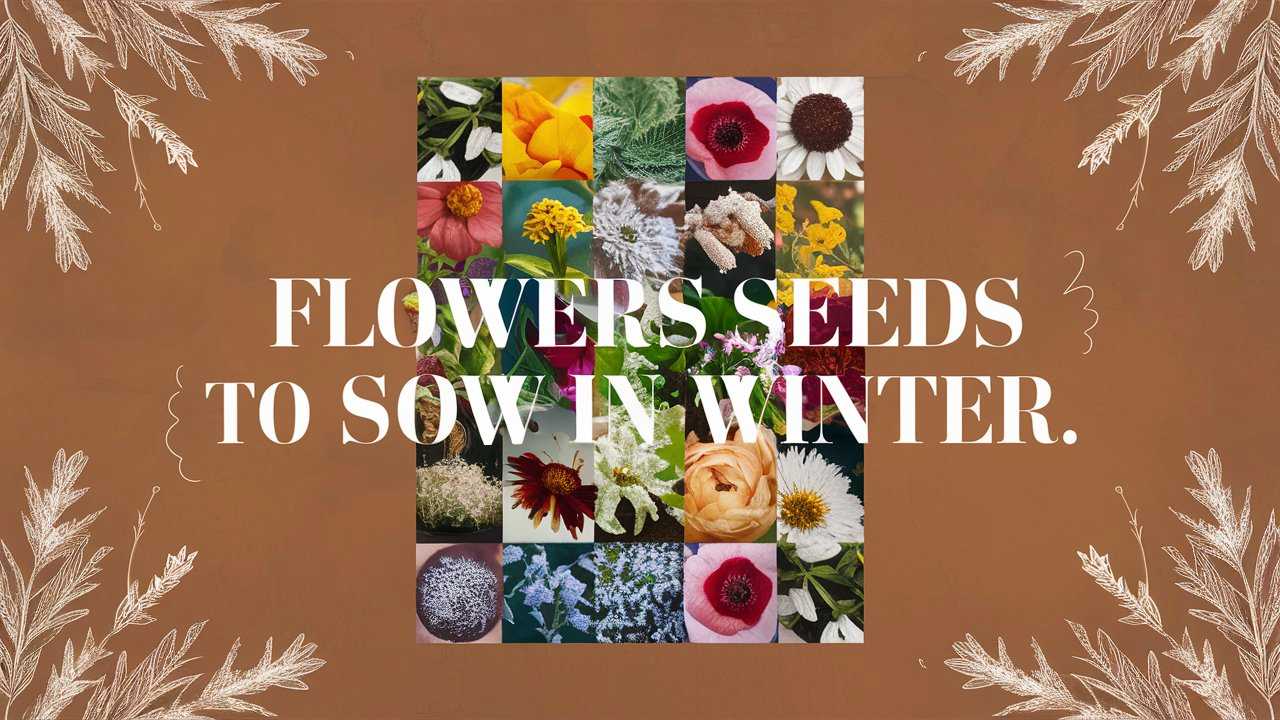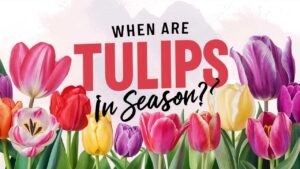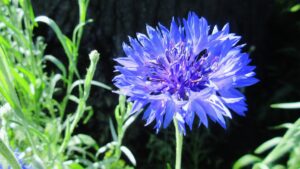As the winter chill settles in, many gardeners may think that their planting days are behind them until spring. However, winter sowing offers a unique opportunity to engage with your garden even during the cold months. This allows you to start certain flower seeds outdoors in winter, utilizing the natural cycles of temperature fluctuations and moisture to germinate seeds gradually.
Poppies (Papaver spp.)
Poppies are iconic flowers known for their delicate petals and dramatic colors, ranging from deep reds to sunny yellows. They are often seen as symbols of remembrance and tranquility. Winter sowing offers a fantastic way to bring these lovely blooms to life with minimal effort.
Poppy seeds, particularly the California poppy (Eschscholzia californica) and the opium poppy (Papaver somniferum), benefit from cold stratification since they naturally germinate after a winter chill. To try your hand at winter sowing poppies, spread seeds over the surface of moist, well-drained seed-starting mix in an open container. Because poppy seeds are tiny and need light to germinate, do not bury them. Cover the container lightly; allow moisture to enter while ensuring adequate airflow.
Poppies will often germinate in early spring, producing stunning blooms by late spring or early summer. They are fantastic for creating dramatic, swathes of color in your garden and are very easy to care for. Additionally, once established, many poppy species can self-seed, meaning they can spread their beauty each year without much intervention.
Johnny Jump-Ups (Viola tricolor)
Johnny Jump-Ups are charming little flowers that add delightful splashes of color to any garden. Known for their cheerful yellow, purple, and white blooms, they are a type of wild pansy and are incredibly versatile, thriving in various conditions from full sun to partial shade.
Sowing Johnny Jump-Ups in winter is an excellent strategy, as these seeds benefit from cold stratification. Start by mixing the seeds with a light, sterile seed-starting mix and placing them in containers with drainage holes. Simply scatter the seeds on the surface, as they require light for germination. Mist the mixture lightly to ensure it’s moist, then place the containers outdoors where they can endure the winter’s chill.
One of the remarkable characteristics of Johnny Jump-Ups is their ability to self-seed, leading to a delightful display of flowers year after year. Plus, they attract beneficial insects, such as bees and butterflies, which play a role in pollination, making them an excellent choice for enhancing biodiversity in your garden.
Chamomile (Matricaria chamomilla)
Chamomile is a beloved herb known not only for its beautiful daisy-like flowers but also for its numerous medicinal properties. Often used to create calming teas, chamomile is a wonderful addition to any garden, combining beauty with utility.
When sowing chamomile seeds during winter, you enhance their natural germination cycle. To begin, mix the tiny seeds with a seed-starting medium and press them gently into the soil’s surface, ensuring they remain moist but not buried, since they also require light to sprout. Place your container outside, allowing the cold temperatures and periodic moisture to stimulate germination in early spring.
Not only is chamomile visually appealing, with its white petals and yellow centers, but it also exudes a pleasant aroma and attracts various pollinators. Additionally, chamomile can be easily harvested in the summer months for tea, making it a rewarding plant for both culinary and ornamental purposes. Its tough constitution means it can thrive in various soil types, making it an adaptable choice for many gardeners.
Spider Flower (Cleome hassleriana)
Spider Flowers, or Cleome, are striking annuals known for their unique, tall flower spikes that bloom in an array of colors, including pink, white, and purple. These plants have a distinctive look, with long, spindly petals that give them an airy and whimsical feel.
Winter sowing Spider Flowers can be particularly rewarding, as they thrive when seeds experience cold temperatures. The process begins similarly to other winter sown flowers: mix the seeds with soil in a container, lightly pressing them in and ensuring they remain on the surface for optimal light exposure. Water the medium well before placing the container outside to endure the winter conditions.
As the temperatures warm, you’ll be rewarded with fast-growing plants that quickly reach heights of 4-5 feet. The blooms, which attract various butterflies and bees, create a dynamic focal point in your garden, providing not only beauty but also a habitat for beneficial pollinators. One of the unique traits of spider flowers is their slight stickiness; they can capture small insects while still promoting a healthy ecosystem in your garden.
Calendula (Calendula officinalis)
Calendula, commonly known as pot marigold, is not only a beautiful flowering plant but also a valuable herb with a long history of medicinal use. With bright orange and yellow blooms, calendulas are known for their ability to thrive in cool temperatures, which makes them perfect for winter sowing.
To begin the winter sowing process, scatter calendula seeds onto a well-drained seed-starting mix in a container. These seeds do not require deep planting; simply pressing them into the surface is sufficient. Water the mix lightly to encourage moisture retention, then place the container outside where it can soak in the cold winter temperatures.
Aside from their vibrant blooms, calendulas are prized for their benefits in the garden. They are natural pest repellents, particularly effective against aphids and nematodes. Their flowers can also be harvested and used to create soothing oils, salves, and teas, making this plant a dual-purpose choice for both beautifying your garden and supporting health and wellness.
Borage (Borago officinalis)
Borage is an extraordinary plant with striking star-shaped blue flowers and fuzzy leaves that not only look beautiful but are also edible. Often used in culinary applications, borage is known for its refreshing cucumber-like flavor, making it a delightful addition to salads and drinks. Winter sowing borage is an effective way to get a head start on this fantastic herb, as it can tolerate cold weather.
To prepare for winter sowing, mix borage seeds with a light growing medium in seed trays. Spread the seeds across the surface, avoiding deep planting, since they prefer light for germination. Water the mixture well and place the containers in an outdoor area where they will be exposed to the elements throughout the winter months.
In addition to its culinary uses, borage is a fantastic companion plant. It attracts beneficial insects such as pollinators and can even improve the overall health of surrounding plants by providing necessary nutrients. The leaves contain high levels of potassium, making them an excellent addition to compost piles, which further enhances your garden’s nutrient profile.
Marigolds (Tagetes spp.)
Known for their vibrant, sunny blooms, marigolds are a staple in many gardens. These flowers boast deep oranges and yellows that can instantly brighten any landscape. Beyond their striking appearance, marigolds are celebrated for their capability to deter pests and attract beneficial insects due to their fragrant foliage.
To successfully winter sow marigold seeds, select a well-draining container and a sterile potting mix. Scatter the seeds across the surface and lightly firm the soil. It’s essential not to bury marigold seeds, as they require light to germinate. Water the mix gently, ensuring it is moist but not soggy, and place the container outside in a location that receives good exposure to winter weather.
The benefits of growing marigolds extend beyond aesthetics. They are known to repel a variety of garden pests, including nematodes and aphids, making them an excellent companion planting choice. In addition, marigolds produce a continuous display of blossoms throughout the growing season, making them perfect for adding long-lasting color to your garden beds or borders.
Rudbeckia (Rudbeckia hirta)
Commonly known as Black-eyed Susan, Rudbeckia is a stunning wildflower that features bright yellow petals surrounding a dark brown or black center. This perennial is beloved for its ability to add intense color and warmth to any garden setting, blooming from mid-summer until fall.
Rudbeckia seeds require a cold stratification period to promote successful germination, making winter sowing an ideal choice. To prepare, fill a seed tray with a quality potting mix and sow the seeds on the surface, lightly pressing them into the soil but not covering them completely, as they need light to germinate. Water the mix to keep it moist and place the tray outdoors to experience the winter freeze-thaw cycle.
In addition to their beauty, Rudbeckia plants are excellent for attracting pollinators like bees and butterflies, making them a wonderful addition to pollinator gardens. They thrive in a variety of soil types and can tolerate drought conditions once established, resulting in low-maintenance blooms that return year after year.
Echinacea (Echinacea purpurea)
Echinacea, or coneflower, is not only a showstopper in gardens with its striking pink, purple, and white blooms, but it’s also known for its medicinal properties. Traditionally used to boost the immune system and fight off colds, this resilient perennial thrives in full sun and well-draining soil.
For successful winter sowing, start by soaking Echinacea seeds in water for 24 hours to help break their dormancy. Then, mix the seeds with a light seed-starting medium and scatter them on the surface of a tray. Firm the soil gently without burying the seeds, as they require light for Germination. Water thoroughly and move the container outside, allowing the natural elements of winter to facilitate germination.
Beyond health benefits, Echinacea flowers are a magnet for butterflies and bees. This makes them a vital player in promoting a biodiversity-friendly garden. Echinacea also self-seeds well, providing a reliable burst of color that returns every year, creating a beautiful tapestry of blooms in your garden.
Columbine (Aquilegia spp.)
Columbine flowers are known for their unique, bell-shaped blooms and their graceful, airy foliage. These delicate perennials come in various colors, including blue, yellow, pink, and white, and are often seen swaying gently in the breeze, adding a touch of whimsy to garden spaces.
Winter sowing Columbine begins with preparing the seeds. These seeds benefit from cold stratification, as well, so they are an excellent candidate for winter sowing. Lightly surface-sow the seeds in containers filled with seed-starting mix, ensuring they sit on top and are not buried too deeply. Water gently, maintaining moisture without over-saturating the soil.
Columbines are not just visually charming; they also attract hummingbirds and beneficial pollinators to your garden, making them a critical component of an ecosystem-friendly planting scheme. Moreover, these plants thrive in a variety of conditions, including partial shade, and can adapt well to different soil types, ensuring their successful growth even in less conventional garden spots.
Yarrow (Achillea millefolium)
Yarrow is a hardy perennial known for its feathery foliage and clusters of tiny flowers that come in shades of white, yellow, pink, and red. This plant is valued not only for its striking appearance but also for its medicinal properties, traditionally used to help with various ailments due to its anti-inflammatory and antiseptic qualities.
When winter sowing yarrow, you’ll want to prepare by either soaking the seeds overnight or simply scattering them on the surface of a seed-starting medium in a container. Yarrow seeds require light to germinate, so it’s essential not to bury them. Instead, press them gently into the soil and mist lightly to establish moisture. Place the container outside, allowing it to experience the freeze-thaw cycle essential for breaking seed dormancy.
Yarrow is also an excellent candidate for attracting beneficial insects like ladybugs and predatory wasps, which help control pest populations. Its ability to tolerate poor soil conditions and drought makes it an incredibly low-maintenance yet visually appealing addition to any garden, ensuring that you’ll have a resilient array of blooms that thrive year after year.
Blazing Star (Liatris spp.)
Blazing Star, also known as Gayfeather, is a stunning perennial known for its long, upright spikes adorned with fluffy, vibrant purple or white flowers. This plant stands out as a striking focal point in gardens and is especially loved by pollinators, making it a valuable addition to pollinator-friendly strategies.
To successfully winter sow Blazing Star, prepare a container with a well-draining seed-starting mix. Scatter the seeds on top of the soil surface without covering them, as they also require light for effective germination. Water lightly to keep the medium consistently moist and place the containers outdoors to take advantage of the cold temperatures throughout winter.
In addition to its beauty, Blazing Star has the added benefit of being a native plant in many areas, which means it is well-adapted to local conditions and provides essential habitat for butterflies and bees. Its long-lasting blooms, which typically emerge in late summer, also make it an ideal choice for prolonging the floral display in late-season gardens.
Anise Hyssop (Agastache foeniculum)
Anise Hyssop is a charming herbaceous perennial that not only offers aromatic foliage but also produces beautiful spikes of violet-blue flowers that are loved by a variety of pollinators. This fragrant plant is often used in teas and culinary dishes, adding both beauty and utility to gardens.
When sowing Anise Hyssop during winter, scatter the seeds over a well-draining potting mix in seed trays or containers, pressing them lightly into the soil to ensure contact without burying them. Water the seeds gently and move the containers outside, where the winter cold will help with natural stratification.
Beyond being a visual delight, Anise Hyssop attracts bees, butterflies, and hummingbirds, making it an excellent choice for creating a pollinator haven. Its drought resistance and ability to thrive in various soil types make it a favorite among low-maintenance gardeners. Additionally, both the flowers and leaves have culinary uses, offering versatility in the kitchen while enhancing the aesthetic appeal of your garden.
Morning Glory (Ipomoea spp.)
Morning Glory is celebrated for its striking, trumpet-shaped flowers that unfurl in the morning sun, providing a dazzling display of colors including blue, purple, pink, and white. These fast-growing annuals are perfect for adding vertical interest to your garden, as they can climb trellises and fences with ease.
To start Morning Glory seeds during winter, it’s beneficial to first scarify them by rubbing the seed coating with sandpaper or soaking them in water for a few hours. This helps break dormancy and promotes germination. After scarification, plant the seeds in a seed-starting mix in containers or trays, ensuring they are buried about half an inch deep. Water thoroughly and set the containers outside where they can experience the cold stratification process.
In addition to aesthetic appeal, Morning Glory flowers attract a variety of pollinators including bees and butterflies, contributing to a biodiverse garden. Their growth habit can also provide natural shade and privacy when grown on pergolas or arches, making them a wonderful choice for creating a more intimate outdoor space.
Milkweed (Asclepias spp.)
Milkweed is more than just a beautiful addition to your garden; it plays a crucial role in supporting local ecosystems, particularly as a host plant for the critically endangered Monarch butterfly. By sowing milkweed seeds in winter, you align with their natural germination process.
Milkweed seeds require a period of cold stratification to break dormancy, simulating the winter conditions they would encounter in the wild. To sow, collect seeds and mix them with a light growing medium in a seed tray or container. After giving them a thorough watering, place them outdoors where they’ll be exposed to the winter elements. Over time, the freeze-thaw cycles will help soften the seed coat, leading to successful germination as temperatures rise in the spring.
In addition to supporting butterflies, milkweed offers lovely clusters of pink, orange, or white flowers in summer, attracting a variety of pollinators to your garden. Plus, as a perennial, it will return year after year, providing essential habitat for wildlife and beautiful blooms.
Moon Flower (Ipomoea alba)
Moon Flower is a captivating relative of Morning Glory, known for its large, fragrant white flowers that bloom in the evening, exuding a sweet scent that attracts night pollinators such as moths. These blooms appear at dusk and close by morning, creating a magical atmosphere in evening gardens.
For successful winter sowing of Moon Flower, the same scarification method applies—lightly nicking the seeds or soaking them will enhance germination. After preparing the seeds, plant them about one inch deep in a well-draining soil mix in a container, watering the soil to ensure it is moist but not overly wet. Position the container outside to benefit from the outdoor winter conditions.
Beyond their dreamy blooms, Moon Flowers are also known for their ability to thrive in poorer soils, making them adaptable in different garden settings. Their vigorous growth can cover fences, trellises, and walls, adding beauty and providing natural coverage while serving as a stunning nighttime focal point.
Additional Flowers to Consider
In addition to Morning Glory and Moon Flower, several other remarkable flowers thrive when sown during the winter months. Here, we highlight a few that can bring joy and vibrancy to your garden landscape:
Sweet Peas (Lathyrus odoratus): These fragrant annual climbers produce stunning flowers in an array of colors, and they can be sown in late winter. They love cool weather and should be sown in a well-draining mix, with the seeds planted about an inch deep. Sweet peas are excellent for attracting pollinators and provide beautiful cut flowers for arrangements.
Snapdragons (Antirrhinum majus): A favorite for their unique flower shape and range of colors, Snapdragons often thrive when sown in winter. They require light for germination, so surface-sowing them in trays and allowing them to experience cold stratification can yield a beautiful display by spring. They are also known for their ability to tolerate cooler temperatures.
Bachelor’s Buttons (Centaurea cyanus): These hardy annuals are perfect for adding a splash of blue to your garden. When sown in winter, they will produce a lovely display in early summer. The seeds can be scattered on the soil surface, watered well, and allowed to endure the winter conditions. Bachelor’s Buttons are also known for attracting various beneficial insects.





















